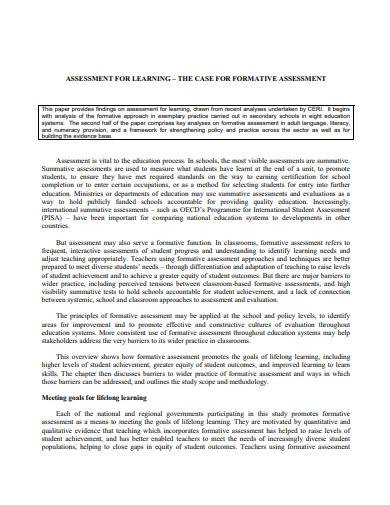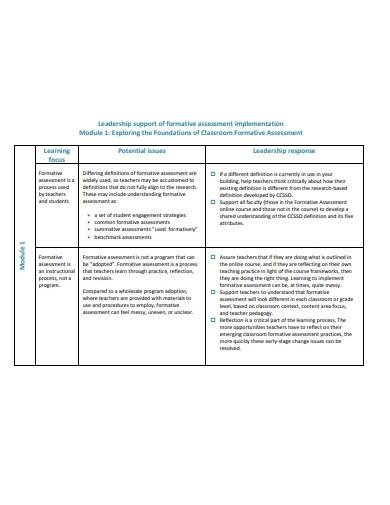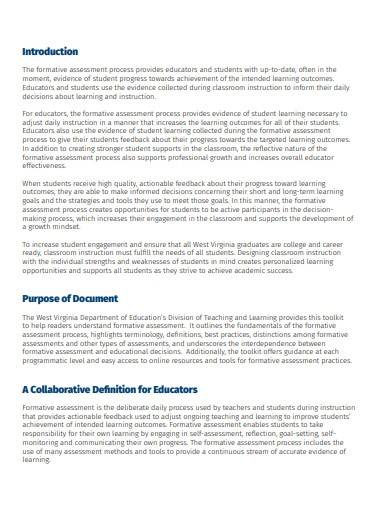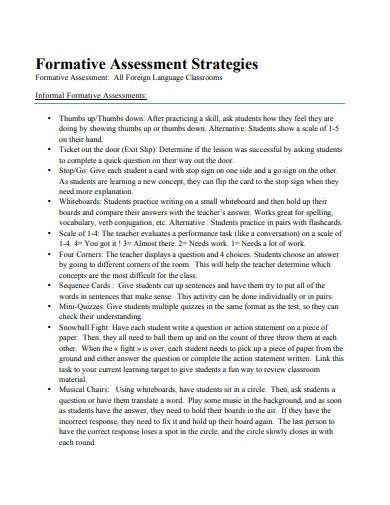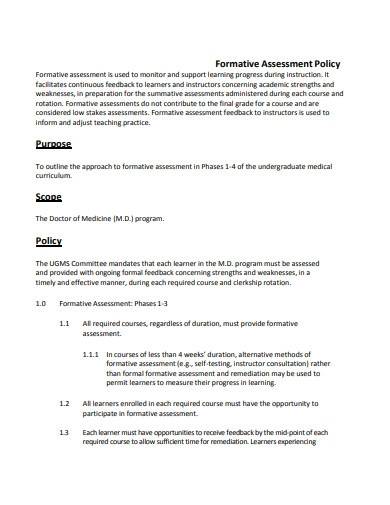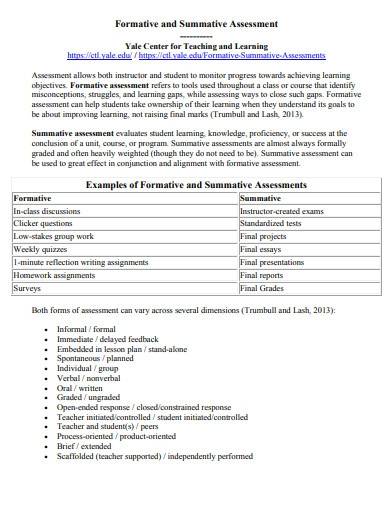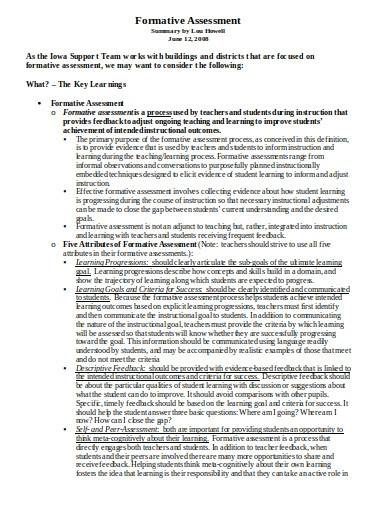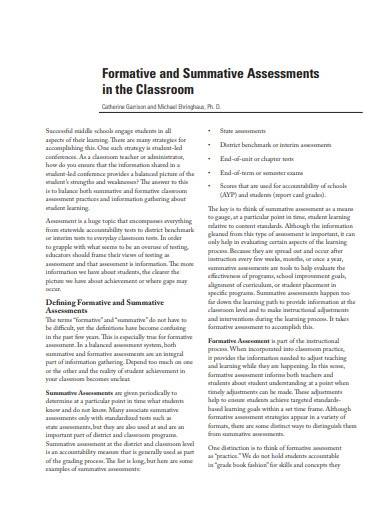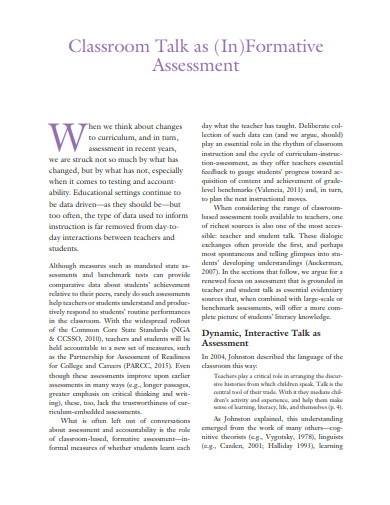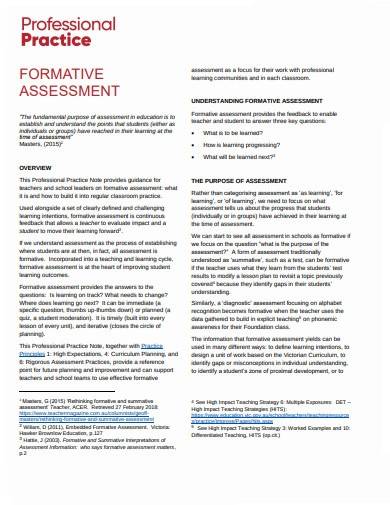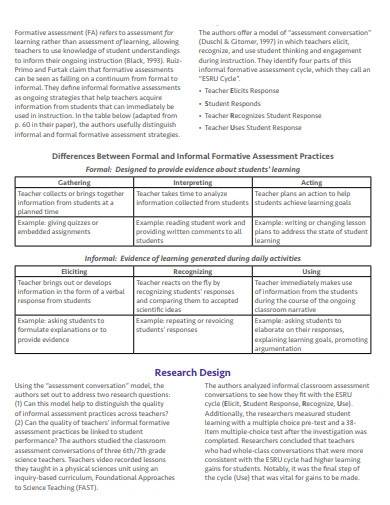The purpose of formative assessment is to monitor the learning needs of students in order to give continuous feedback samples that can be used by elementary teachers to improve the quality of their sample instruction and by students to improve the quality of their own educational development. To be more specific, formative evaluations help students identify their strengths and shortcomings and target areas in which they need to improve, while also assisting teachers in recognizing areas in which students are having difficulty and immediately addressing these issues.
FREE 10+ Formative Assessment Samples & Templates
1. Formative Assessment Template
2. Sample Formative Assessment Template
3. Sample Student Formative Assessment
4. Formative Assessment Strategies Template
5. Sample Formative Assessment Policy
6. Formative and Summative Assessment
7. Sample Formative Assessment
8. Formative and Summative Assessment in Classroom
9. Educational Formative Assessment
10. Professional Formative Assessment Template
11. Standard Formative Assessment Template
What Is Formative Assessment?
A formative assessment essay is a type of writing assignment that is used as a tool for evaluating student learning and understanding during the student learning process. It is an informal, quick and regularly done assessment that helps teachers to monitor student progress, identify areas of difficulty, and adjust teaching assessment methods or instruction to better support student learning. These essays are typically shorter than summative essays and are often used to assess a specific skills development or concept.
How To Make a Formative Assessment?
Formative assessments are a way to check the students’ understanding of the material and can provide valuable information to the teacher about what the students are struggling with or what the class as a whole needs to work on more. Making a formative assessment can involve several steps:
Step 1- Learning Objectives
Start by clearly identifying the learning objectives or goals for the lesson, unit, or academic course. This will help you to determine what you want to assess and what specific skills or concepts you need to evaluate.
Step 2- Select Assessment
Choose assessment methods that align with the learning objectives and the type of knowledge or skill you want to evaluate. Formative assessments can take many forms, including quizzes, short-answer questions, open-ended questions, discussions, observations, or essays.
Step 3- Design Assessment
Create assessment items that align with the learning objectives and the type of knowledge or skill you want to evaluate. The questions or tasks should be clearly written, relevant, and appropriate for the students’ level of understanding.
Step 4- Administer Assessment
Conduct the assessment with your students in a way that is appropriate for their age, skill level, and the content of the assessment. Be sure to provide clear instructions and enough time for students to complete the assessment. Besides, you can review the results of the assessment and analyze the data to identify patterns and areas of difficulty. Look for trends in student performance, and use the information to inform your instruction and make adjustments as needed.
What is the difference between formative and summative assessment?
Formative assessment focuses on evaluating student learning and understanding during the learning process, while summative assessment evaluates student learning at the end of a lesson, unit, or course.
Why is formative assessment important?
Formative assessment is important because it helps teachers to monitor student progress, identify areas of difficulty, and adjust teaching methods or instruction to better support student learning. It also provides valuable information about what students are struggling with or what the class as a whole needs to work on more.
How often should formative assessments be administered?
The frequency of formative assessments depends on the specific learning objectives and the type of instruction being used. Some teachers administer formative assessments daily, while others use them less frequently. It’s up to the teacher’s preference, yet doing regularly is recommended.
Formative assessment is important because it helps teachers to monitor student progress, identify areas of difficulty, and adjust teaching methods or instruction to better support student learning.
Related Posts
FREE 10+ Notice of Assessment Samples in PDF | DOC
FREE 8+ Labor and Delivery Assessment Samples [ Nursing, Risk, Newborn ]
FREE 3+ Child Biopsychosocial Assessment Samples in PDF
FREE 10+ Workshop Risk Assessment Samples [ Vehicle, Engineering, Fire ]
FREE 10+ Environmental Risk Assessment Samples [ Health, Social, Impact ]
FREE 3+ Client Biopsychosocial Assessment Samples in PDF
FREE 10+ Event Risk Assessment Samples in PDF | MS Word
FREE 10+ Joint Assessment Samples [ Strategic, Risk, Needs ]
FREE 10+ Teleworker Self-Assessment Samples in PDF | DOC
FREE 10+ Market Assessment Samples in PDF | MS Word
FREE 10+ Quality Risk Assessment Samples [ Control, Assurance, Management ]
FREE 6+ Immediate Termination of Lease Agreement Samples in MS Word | Google Docs | Apple Pages | PDF
FREE 10+ Qualitative Risk Assessment Samples in PDF | DOC
FREE 10+ Comprehensive Needs Assessment Samples in PDF
FREE 10+ Evaluation Quality Assessment Samples [ Self, Loss, Data ]

